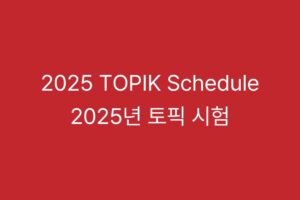
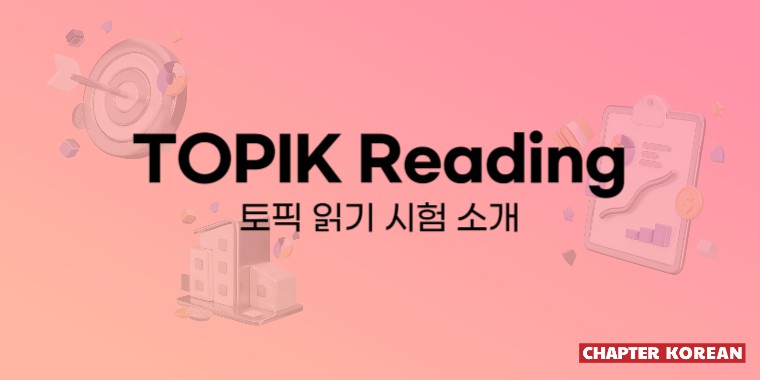
Hello, Korean learners! You’ve probably heard of TOPIK (Test of Proficiency in Korean). This test is one of the keys that opens the door for many people who want to learn Korean. In particular, TOPIK reading test is one of the important parts that tests in-depth understanding and application skills of the Korean language.
In this blog, we’ll focus on the TOPIK reading test, taking a closer look at the test’s structure, main topics, and effective preparation strategies. Among TOPIK 1 and TOPIK 2, we will look at various aspects of the TOPIK test, paying particular attention to the TOPIK 2 reading test.
Let’s learn about the TOPIK test together and share various tips and strategies to help you improve your Korean language skills and achieve a high score. If you’re ready, let’s get started together!
(Test of Proficiency in Korean, TOPIK) is a national organization. The TOPIK test is divided into listening, reading, and writing parts. Today, we will focus on TOPIK reading test.
(*See the previous article, TOPIK 2 Writing)
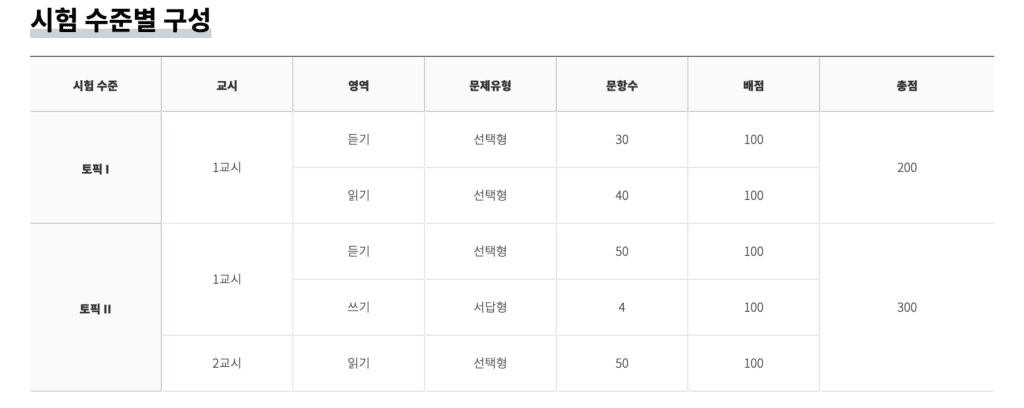
There are a total of 40 reading questions in the TOPIK 1 test. There is a total of 100 points and the questions are multiple choice. There are a total of 50 reading questions in the TOPIK 2 test. It is also a total of 100 points and the questions are multiple choice. A multiple-choice question means that you have to choose one correct answer from 1 to 4.
The TOPIK 2 reading test consists of a total of 50 questions, and each question has a variety of types. This diversity requires learners to explore different aspects of the Korean language and gain a broad understanding. Now, let’s learn about the main question types that frequently appear in the TOPIK 2 reading test.
Questions 1 and 2 of the TOPIK reading test involve choosing the appropriate word to fill in the blank according to the grammar. In question 1, a conjunctive ending appears, and in question 2, a concluding ending appears. Because it is a very easy problem, anyone who has studied the basics well can easily solve it. You should study grammar little by little on a regular basis and solve problems quickly.
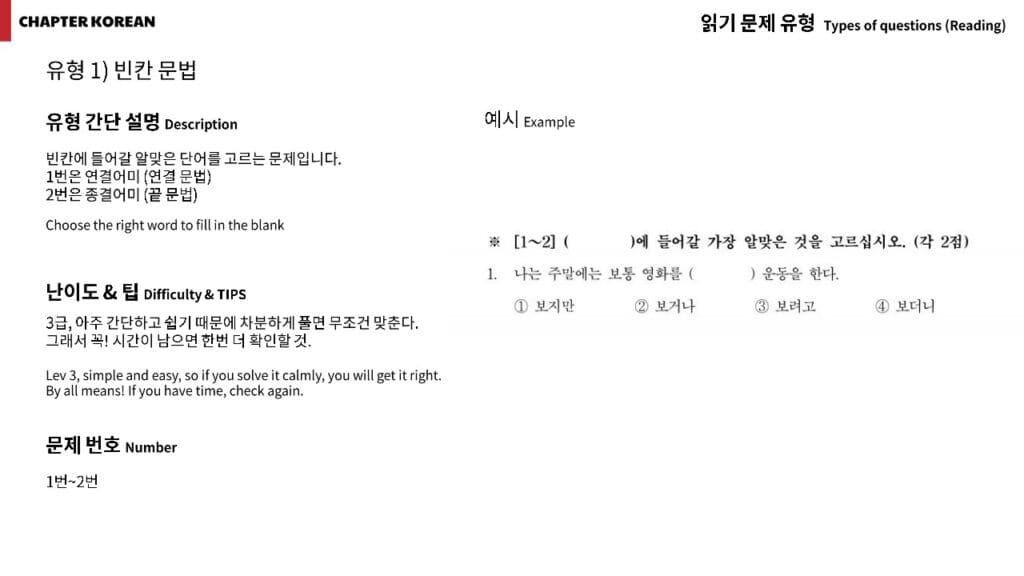
Questions 3 and 4 of the TOPIK Reading Test are about choosing something that has a similar meaning to the underlined part. The problem is to choose a word with a similar meaning according to the grammar of the underlined part. In question 3, a conjunctive ending appears, and in question 4, a concluding ending appears.
As expected, it is a very easy grammar problem that anyone who has studied the basics well can easily solve. You should study grammar little by little on a regular basis and solve problems quickly. Solving these types of problems accurately is important, but solving them quickly is also very important.
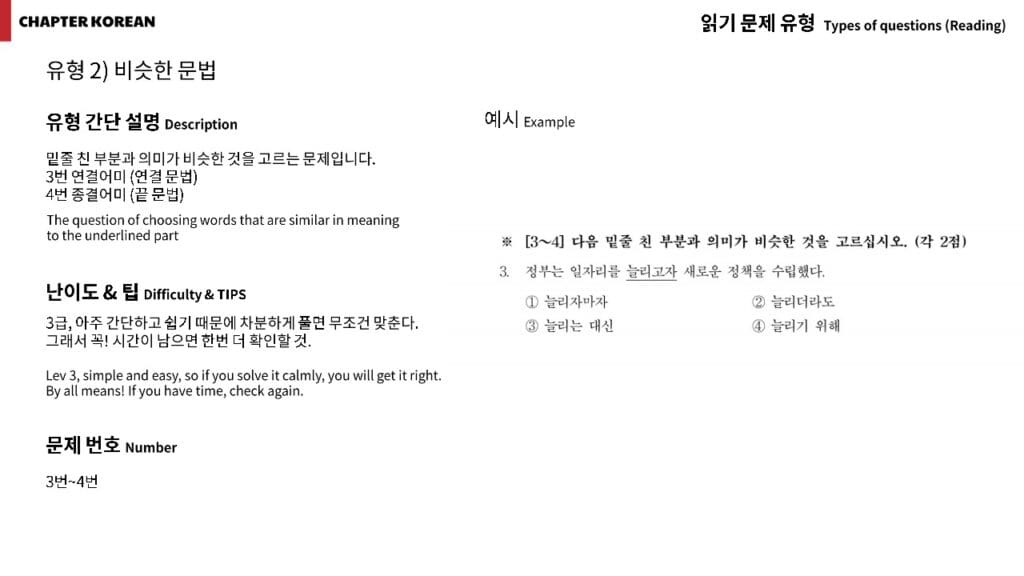
TOPIK reading test questions 5 to 8 require you to look at various advertisements and guess the answer. Problems arise with product advertisements, corporate advertisements, public service announcements, manuals, and notices. This is one of the easier reading test questions, so you must be able to answer it correctly. Even if you are at level 3, you can definitely get this question right.
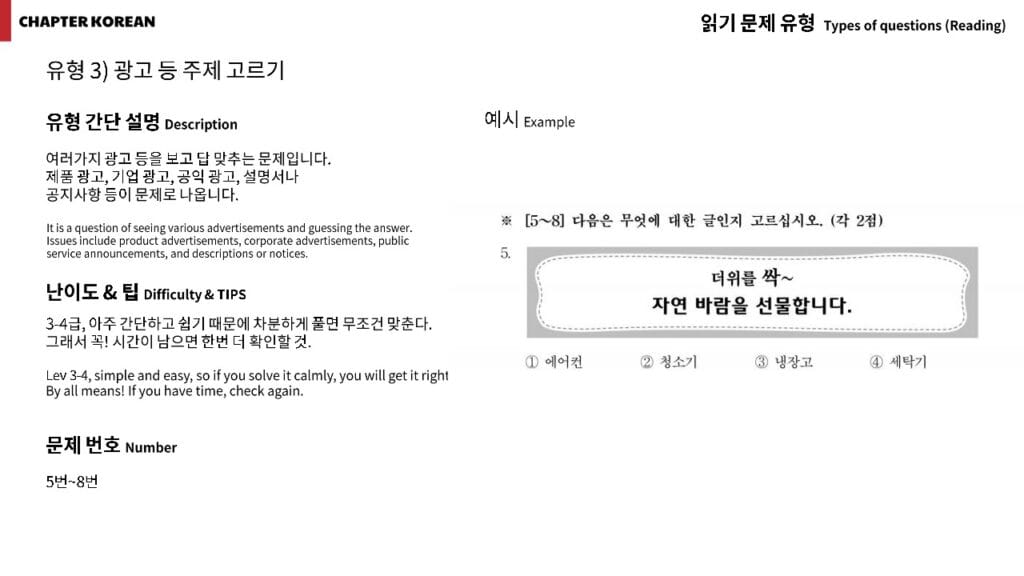
Questions 9 to 12 of the TOPIK reading test ask you to select the same content by looking at text or graphs. Topics include guides, tables/graphs, news and newspaper articles, etc. This is a level 3-4 question and is simple and easy, so if you take your time and calmly solve it, you can definitely get it right.
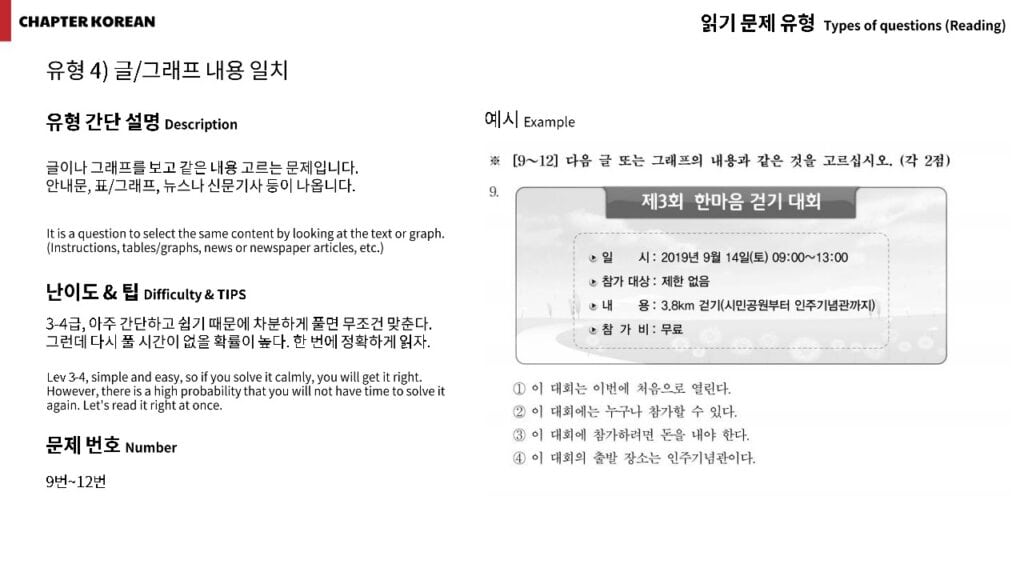
TOPIK reading test questions 13 to 15 are about arranging sentences in order. You must read and think carefully about the connecting expressions between sentences to solve the problem. You must think carefully about time, sequence, and cause/effect expressions to solve problems. It’s an easy problem, so you should solve it well in one try.
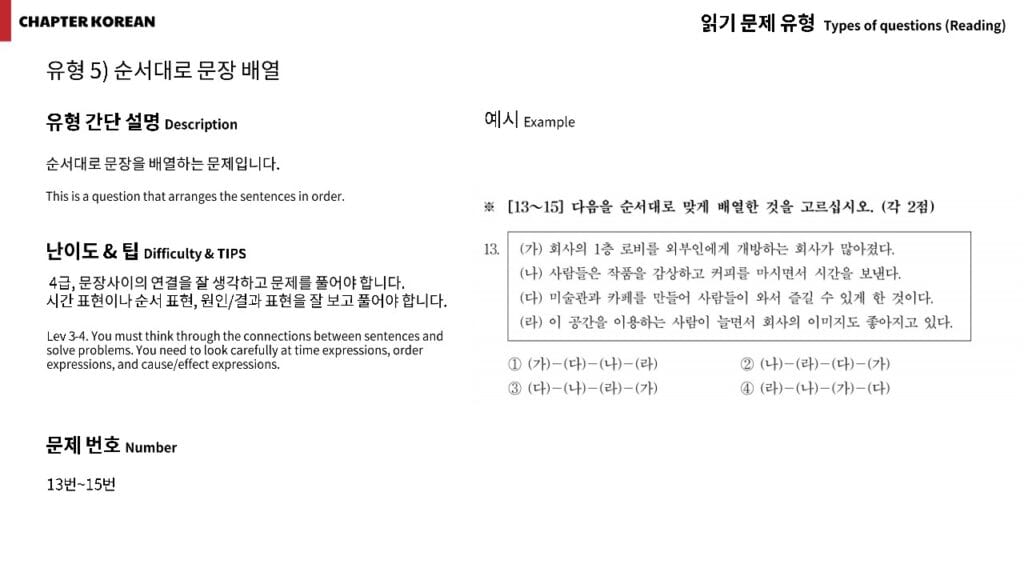
Questions 25 to 27 of the TOPIK Reading Test are about understanding the meaning of newspaper article titles. You can solve the problem by knowing the exact meaning of the word, grammar, or expression. It can be considered a level 4 or 5 question because it evaluates accuracy, prediction ability, and logic. Even if you don’t know a word, don’t give up; you can easily solve the problem by thinking about the flow of the sentence and figuring out which sentence goes best with it.

Questions 39 to 41 of the TOPIK reading test ask you to choose the most appropriate place to put a sentence. It’s a question of reading the sentences and choosing the right place. This type also appears in difficult complex problems later.
Words such as ‘이, 그, 저, this, that, that’ or ‘그래서, 그러나, 하지만, so, but’ can act as hints and help solve problems. A good solution is to try solving the problem one more time, suspecting that even if you find the answer, you might end up in the last sentence.

The most common question in TOPIK reading test 35 to 38 and in complex questions is the question of choosing an appropriate topic. This is a test where you have to read a long text and choose the sentence that best fits the topic. For problems like this, it’s important to quickly grasp the topic.
The central sentence containing the topic of the article usually appears at the beginning, middle, or end of the article, so a good way to solve the problem is to quickly understand the structure of the article, find the central sentence, and quickly identify the topic. Mindlessly reading and solving a text from beginning to end is a bad method that reduces accuracy and takes a long time.
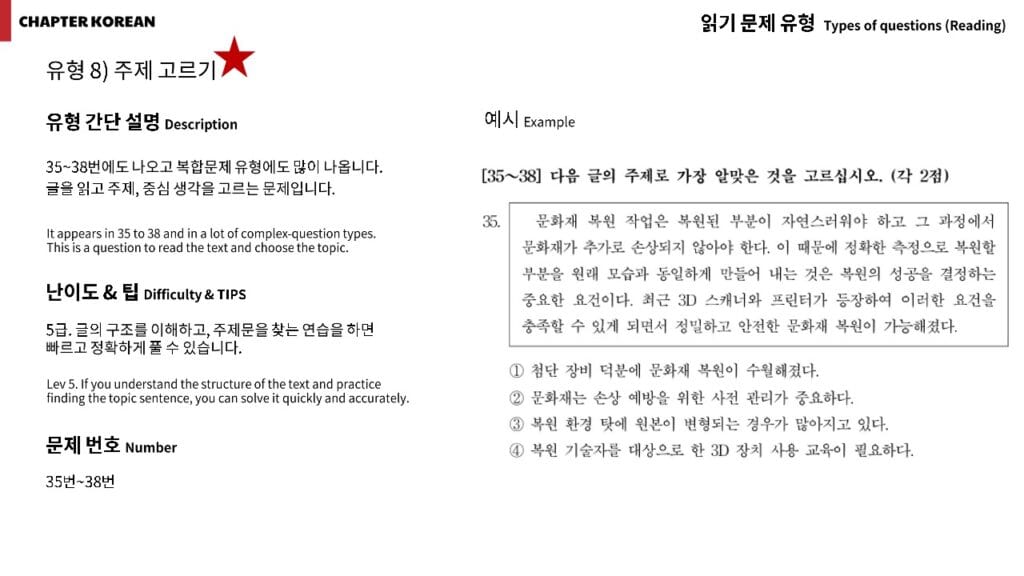
This is the question of choosing the right sentence for the blank space in the TOPIK test, which is the most complex and difficult for students. It is a matter of reading the text and choosing the most appropriate sentence within the ‘parentheses ( )’. This is also the type of problem that comes up most frequently in topic reading. Usually, when solving a problem like this, many students think that they have to read the entire text to solve it, but instead of reading the whole text, they quickly understand the topic, connect it well with words such as ‘but, but, so’, and think logically to solve the problem. This is very important.
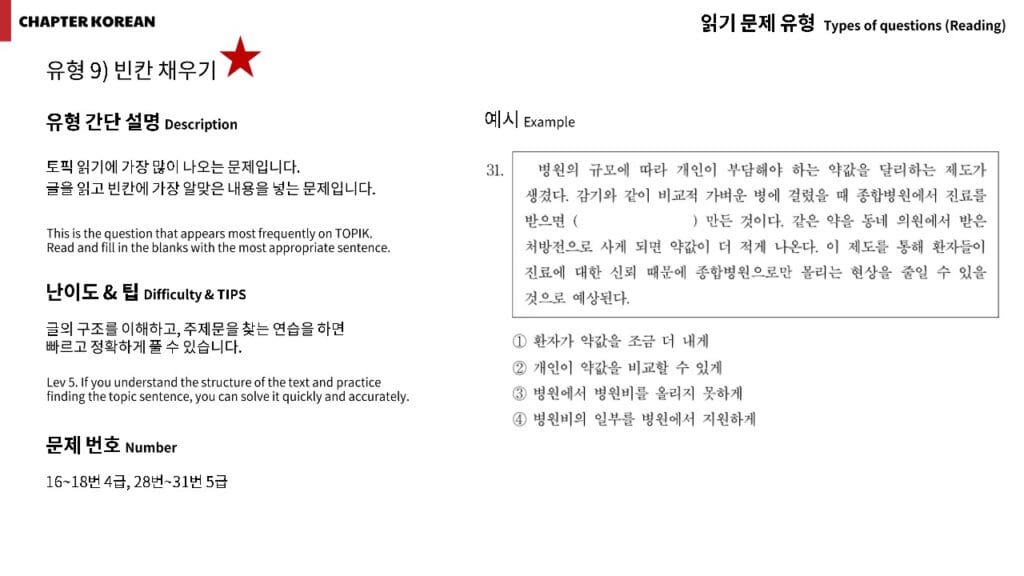
There are questions where two or more questions are mixed together during the TOPIK reading test. For example, in the case of numbers 44-45, 46-47, and 48-50, 2 or 3 questions appear at once. Usually, problems such as choosing a topic, matching content, and finding sentences that fit the blank appear all at once. Problems that combine multiple problems, such as questions 48 to 50, require learners to apply a variety of reading strategies.
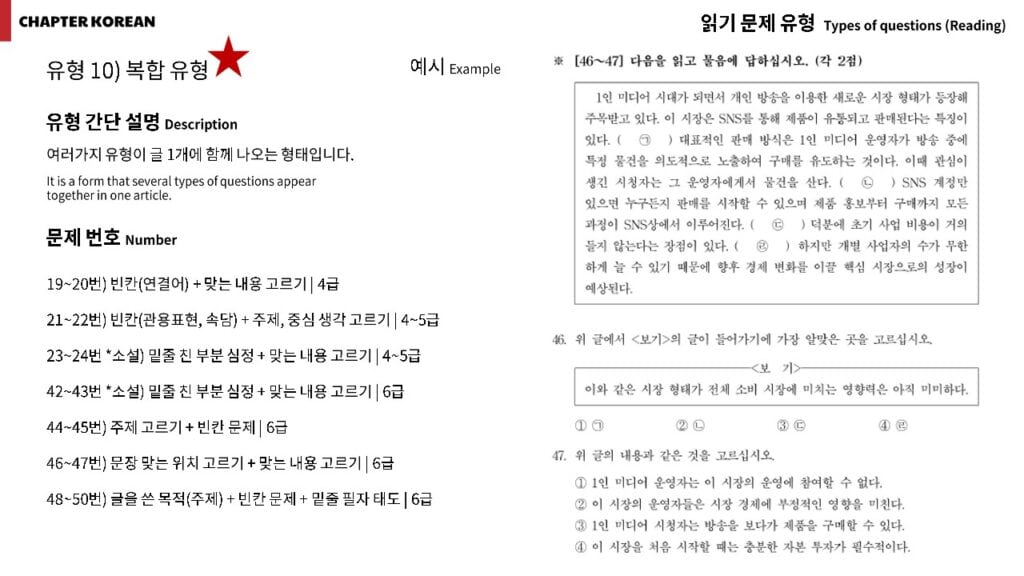
The TOPIK 2 reading test requires Korean learners to have a higher level of language understanding and use than anything else. Therefore, test preparation should focus not only on problem-solving skills, but also on developing high-level reading skills and language comprehension.
In order to prepare for the various types of questions that may appear on the test, it is important to develop the ability to analyze sentence structure and understand the overall flow of the text. This will also help you improve the skills you need to actually read and understand Korean, rather than just working towards a specific test.
This is an opportunity to not only pass the TOPIK 2 reading test, but also improve your Korean language skills and develop your ability to understand texts in various fields and communicate broadly. Therefore, preparing for the test is not just for taking the test, but is an important step to improve your Korean language skills.
Understanding the TOPIK test question types and preparing effectively is an important process not only for achieving good scores on the test, but also for comprehensively improving your Korean language skills. In the process of preparing for various types of problems, learners can improve their vocabulary, sentence comprehension, and ability to understand the structure of writing.
The TOPIK test is not just a language test, but a test that broadly verifies the skills needed to live and communicate using Korean. Therefore, the process of preparing through problem types contributes to improving broad skills across languages. These skills will enable effective communication not only in the process of learning a language, but also in real-life situations.
Preparing for TOPIK test question types will not only greatly contribute to improving your language skills, but will also help you deeply understand and apply various topics in Korean. You may encounter difficulties during this process, but through continued effort and the joy of learning, you will be able to enjoy the journey of achieving your goals. With sufficient effort and preparation, we hope to improve your Korean language skills to the next level through the TOPIK test!
Do you want to study Korean more? Do you want to study more about TOPIK reading?
Click the link below to sign up for the class. TOPIK 2 reading class
You can receive class consultation through KakaoTalk. Chapter Korean KakaoTalk
Chapter Korean provides intermediate and advanced Korean language education. Study Korean with us.


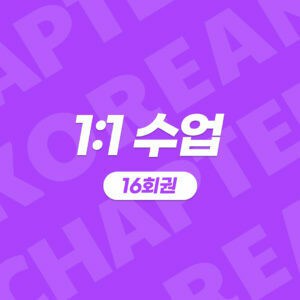

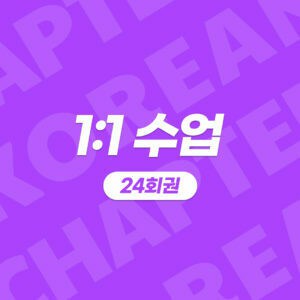

주식회사 챕터코리안, 대표 김대광 | 사업자등록번호 : 471-88-02872 | 통신판매업신고번호 : 제2024-서울중구-1387호| 서울 퇴계로 36길 2 812호
대표번호 : +82-10-2981-4359 | 이메일 : [email protected]
이용약관 | 개인정보처리방침 | Cookie Settings
Copyright 2023 © ChapterSeoul